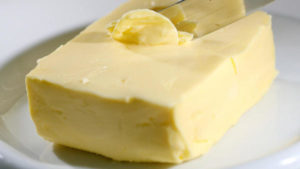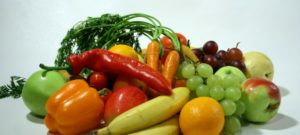In this article we present 4 food tips about food and nutrition that you don’t know. Click on the anchors to the respective point:
- The light lie
- Why there is little to keep up with nutrition tips
- Change eating habits successfully
- Fighting hunger effectively
- The power of herbs
etc;
The light lie
From margarine to delicatessen salad: What you should consider when buying.
margarine:
40 calories in one go: This much is saved per 10 g of spreadable fat, if you replace the full-fat margarine with one with only 28 % fat. Sounds good to me. But:
A natural foodstuff looks different. No matter whether full-fat, half-fat or dietary margarine: the vegetable oils are broken down into their constituents using high technology and reassembled to turn them into liquid solids. Emulsifiers and gelatine help, the flavour is produced by the flavouring industry.

The slimmed-down variants simply do not taste as good as butter or full-fat margarine. However, you should like (learn) them a little, only then does saving fat make sense. Because if you chastise yourself, you will make up for lost enjoyment elsewhere.
Blockquote>Frequent trap: Spread the slim fat a little thicker or, even more fatal, put more coating on it.
- Grab rather:
cream cheese, or – thinly coated – butter. If it is a fat-reduced margarine, you should always pay attention to its composition: Prima are omega-3-rich varieties and margarine based on rapeseed or olive oil. Not so good: varieties with lots of sunflower or safflower oil.
sausage:
Additives such as “Balance”, “AktiFit” or “Leichter Genuss” quickly add a halo of health to even a small fat bomb like sausage. A few facts:
if the fat content is above 15%, sausage is still heavyweight. By comparison, boiled ham contains only about 4% fat. Popular fat substitutes are apple fibres, pea flour or inulin. They’re not harmful, but they don’t taste like sausage. A few more flavours are needed for this. Really useful: If a part of the fat saved is replaced by lean meat mass.
Those who eat a lot of sausage can lose weight by consistently replacing the topping with low-fat variants. This was shown in a Göttingen study.
- Grab rather:
Ham: lots of meat and few additives, and you can omit the fat edge. Organic products not only come from happier pigs, they also contain fewer additives.
sweets:
Actually dreamlike: chocolate kisses and sweets “sugar-free”, double biscuits with “30 % less sugar”. But all this is not possible without a hook:
“sugar-free” for classic sweets means: They contain isomalt or maltitol syrup. But both have a lot of calories (240 kcal/100 g). In addition, the sugar substitutes from about 10 to 20 g (equivalent to about 2 chocolate kisses) have a laxative effect.
In order for the sweetness to be right, sweeteners are often added.
Sweets “without granulated sugar” often contain fructose (fructose). It has the same number of calories and increases blood fat levels.
- Grab rather:
Real sweets (in healthy measure, of course). They really satisfy the sweet tooth.
yogurt:
Let’s face it: 3.5 g fat per 100 g is basically not much. And yet this healthy food saves fat as if it were a liver sausage. These facts will help you make your choice:

“Diet yogurt” is intended for diabetics, almost always contains sweeteners. Natural yoghurt with 0.1% fat has only 10 kcal less than that with 1.5%, as it contains more protein and carbohydrates. The less fat and calories in the cup, the more thickeners, sweeteners and flavours are used.
- Grab rather:
Fruit yoghurts with less sugar. Or organic fruit yoghurt with 1.5% fat: you have no aroma additives, but more fruit.
Chips & Flips:
Food technologists nowadays also get the tempting crunchy feeling of eating well with fat-reduced chips. Still, there’s a lot to be said against her:
The fat content: Even chips with “30% less fat” usually still contain around 25 g of fat and almost 500 calories per 100 g!
Flavours and flavour enhancers encourage you to eat more.
- Grab rather:
savoury pastries, unpeeled pistachios or peanuts. What if it has to be chips? It is best to take pure from potatoes, vegetable oil and salt. Most important: buy as small bags as possible and take only a small portion with you to the TV sofa.
Beverages:
If you want to lose weight or keep your weight and can’t do without soda and cola, you should actually replace it with a light version. This is recommended by the German Nutrition Society. However, according to Dr. Thomas Ellrott, a weight loss expert from Göttingen, some people find sweets to whet their appetite for sweets. That’s another argument against it:
Even the originals contain water and above all additives: aromas, acidulants (attack the enamel), dyes. Sweeteners are added to the light variant.
According to a US study by Boston University, large amounts of light drink increase the risk of metabolic syndrome (diabetes, obesity, high blood pressure, poor blood lipids).
- Grab rather:
Water! In between it can be a light spritzer (maximum 25 % juice) or an organic soft drink with little sugar. But drinking sweet is a habit. And with a little patience you can take them off again.
Why not much to keep up with nutrition tips
There are always new studies about supposedly healthy food. This is confusing and often even wrong. It’s best not to listen!
Sugar makes us sick, broccoli protects against cancer, cocoa against heart attacks – hardly a week goes by without being bombarded with new research on food and the appropriate nutritional advice. They are published by “experts” on behalf of the food industry, ministries, specialist societies and other institutions, which often have their own, tangible interest in influencing our nutrition.
Unfortunately, the past has shown that many of the tips were simply wrong.
For example, that a low-fat diet is healthier. As a result of the low fat terror, many people believed that they already eat healthy if they only eat low-fat products. Far from it: They then consumed more carbohydrates, became thicker and thicker, and many fell ill with typical secondary diseases such as diabetes and high blood pressure.
Therefore I dare to doubt that all recommendations for healthy nutrition are scientifically based. Too often they are contradictory, for example when it comes to coffee. Studies have shown that it sometimes has a calming effect, sometimes it damages the circulation. Sometimes it promotes concentration, sometimes it makes you nervous. Poor nutritionists, it’s not easy for you! Your studies depend on many unknown or hardly measurable influences. Nevertheless, there is more talk and writing about nutrition today than ever before. I’m more at a loss than smart.
Therefore I can only recommend you not to follow any more advice. Except for these: Eat whatever you want in peace and quiet! The main thing is variety. Discover the natural, unprocessed products of your region and plunge into the adventure of cooking for yourself. Enjoy with family and friends – and your health will benefit the most.
Change eating habits successfully
Allow yourself more quality and enjoyment!” If you want to change your eating habits successfully, you should be good to yourself.
The daily portion of vegetables is healthy, but not everyone likes it. Researchers have shown: If you give children something to try out often enough, they’ll like it at some point. Is that possible for adults?
Only within certain limits, most of which are determined by the culture in which you grew up. No matter how many insects you could be given – which in other cultures are part of a normal diet – they would probably not become your favourite food.
Are you nailed to what you liked to eat as a child?
A little bit, yes. Unless you haven’t had a disgusting experience with a meal and haven’t eaten so much of it that you can’t see it since then, your childhood preferences will last a lifetime. But they can be expanded.
Maybe such a trick for children helps: mix some vegetables with mashed potatoes, then gradually increase the proportion. By getting used to it, broccoli or spinach will also taste good at some point. Is this also feasible for us in everyday life? Everything can’t be made tasty that way. There will always be individual dislikes that can’t be outwitted even with tricks. I’ve got the beetroot. But I don’t think much of tricks anyway, there are better ways to get children to like it.
Example?
Choose and have it prepared. be a role model and eat vegetables with pleasure.
 But above all, stop imposing certain foods on children as “healthy”. This can only backfire. We repeatedly see the result in surveys in which children make a very clear distinction between “tasty” and “healthy” food. And they associate the latter with nerviness, paternalism and coercion.
But above all, stop imposing certain foods on children as “healthy”. This can only backfire. We repeatedly see the result in surveys in which children make a very clear distinction between “tasty” and “healthy” food. And they associate the latter with nerviness, paternalism and coercion.
Will it last into adulthood? That can happen. But even if you later find a taste for vegetables, the more or less unconscious distinction between “good” and “bad” foods persists. This is problematic because sweets and fast food retain the appeal of the forbidden. This feeling: “Now I treat myself”, offers only something “sinful”.
Can such conditioning be repaired as an adult?
Just hard. We are told all the time how a healthy diet should be. And it’s never what people actually eat. I hear all the time: You eat too much, too fat, too sweet, too salty. The subliminal message that reaches the people is: You’re too dumb to take care of your bodies sensibly. Not exactly helpful for the goal of giving people more confidence in their own abilities. This means both nutritional competence – the ability to assess the quality of food and prepare it – and the ability of the body to feel what it really needs.
Block rate>Nutritional psychologists have shown that renunciation is useless in the long run.
But how can one manage to give in to one’s appetite and still not only eat chocolate and pizza? Only with small steps, not by denying. It is always good to keep a food diary for a while and write down what you ate in which situations. This explains many behavioural patterns such as eating under stress or out of boredom. You can also see which foods and meals really mean something to you and what you can give up without minding much. Then you take individual small steps, try one after the other what works for you, and – very important! – calculates from the outset that some things may fail at first.
Why is that so important?
People tend to blame themselves if something doesn’t work right away and throw down the whole project. It helps to make oneself clear: Every change of old habits requires for a while the conscious control of the behavior, and that costs strength! In addition, all changes create resistance – in oneself, but often also in the social environment.
So this is about finding your own way? Exactly. And this should lead away from the stereotypes “healthy” or “not healthy”, away from renunciation and towards the attitude of indulging oneself more: more quality, more eating culture with beautifully laid tables as well as time and leisure for eating in pleasant company – and not least more enjoyment. Because most of what makes you fat and endangers your health is not worth it!
etc;
Heating hunger effectively
Concrete steps with which you can steer hunger and appetite into figure-friendly paths.
If possible always eat slowly and concentrated. Chew and taste every bite very consciously and enjoy your meal! Treat yourself to high-quality food, a beautifully laid table, leisure and a pleasant atmosphere. Avoid arguments and television while eating.
Train your feeling of satiety by feeling yourself again and again during a meal. Stop as soon as the hunger is gone, even if they could eat any more.  You are right if you still feel full half an hour after eating, but not stuffed.
You are right if you still feel full half an hour after eating, but not stuffed.
Reduce the energy density of your meals.
More promising than the elimination of fat is the addition of fruit and vegetables. For breakfast and sandwiches, add paprika, tomatoes, cucumbers or carrots as well as some fruit to the table.
Avoid products containing flavour enhancers, flavours, sweeteners and fat substitutes. All of them are well-founded suspected of increasing their appetite. This is especially true for glutamate.
Use smaller plates, bowls and spoons. The eye also determines when you feel full. The larger the dishes, the more harmless the portions seem – you automatically eat more without feeling fuller or eating less during the day.
Make it harder to snack. Instead of rigorous bans, the sweet stuff should just not be attainable with a simple grip. Those who have to go into the back corner of the cupboard or even into the cellar have proven to nibble less than when the chocolate is always in sight.
etc;
The Power of Herbs
If you want to lose weight “green”, you can eat your fill in the morning, at noon and in the evening. A flexible diet, combined with exercise and relaxation, ensures that you get into shape.
Morning your day starts with the smell of freshly baked bread.
A slice with herb curd cheese and tomato slices, if you like it hearty, or with orange curd cheese and some honey for sweet beaks. For the latter, mix 1 tbsp low-fat curd cheese with some orange peel and 1 tbsp orange juice. Also delicious: instead of honey, soak 35 g cranberries in water for 15 minutes, then puree. If you don’t like eating in the morning, have a glass of Barley Water (see right) and take the bread to work. This breakfast provides satiation and healthy digestion with plenty of dietary fibres; the blood sugar level rises only slowly. The protein from low-fat dairy products increases saturation and provides valuable calcium.
Lunchtime salad is on the menu.
It provides vitamins as well as mineral and bioactive substances en masse with few calories! That makes t for the second half of the day. Many herbs in dressing, combined with lean protein from whey, fish, meat or cheese, stimulate fat burning. If you want to lose weight “green”, you can eat your fill in the morning, at noon and in the evening.
A good diet combined with exercise and relaxation will keep you in shape. The power of herbs does not give you the infamous yo-yo effect.
Another advantage: only 80 percent of the calories are available to us. The rest is used directly for heat production. Mix 2 handfuls of green salad (lettuce, lamb’s lettuce, iceberg lettuce, endive lettuce or oakleaf lettuce) and a handful of finely chopped boiled vegetables or legumes. Add an egg (or a slice of turkey ham, a handful of shrimps, 50 g feta light). The dressing is prepared as a stock to save time. There’s a slice of spring bread with it.
Evenings are freshly cooked.
The core of this meal is an extra large portion of protein (e.g. from fish, seafood, pork, turkey or beef, cheese). This way you can slow down your cravings for a sweet bedtime sweetener. Many vegetables and herbs provide the body at the end of the day with a portion of vitamins and minerals. Calcium in particular is well stored overnight by the body. Important for the whole day: Drink enough! 2 litres a day would be ideal – preferably water, unsweetened herbal and fruit tea. Enough fluid also helps to overcome performance lows.




